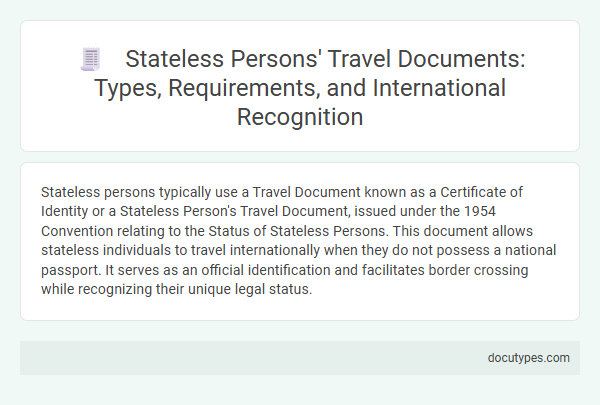Stateless persons typically use a Travel Document known as a Certificate of Identity or a Stateless Person's Travel Document, issued under the 1954 Convention relating to the Status of Stateless Persons. This document allows stateless individuals to travel internationally when they do not possess a national passport. It serves as an official identification and facilitates border crossing while recognizing their unique legal status.
Overview of Stateless Persons’ Travel Documents
Stateless persons often face unique challenges when traveling due to the lack of nationality. Your travel document for identification and movement is typically a stateless person's travel document issued under international conventions.
This travel document serves as official identification and allows border crossings where visas may be required. It is recognized under the 1954 Convention Relating to the Status of Stateless Persons, providing legal protection during travel. Issuance depends on the country of residence, which follows guidelines to assist stateless individuals in international mobility.
Types of Stateless Persons’ Travel Documents
Stateless persons require specific travel documents that recognize their unique status. These documents allow them to cross international borders when they lack nationality.
The most common type is the 1954 Convention Travel Document, issued under the United Nations framework. Another important document is the Certificate of Identity, which some countries provide to stateless individuals for international travel.
Historical Background of Stateless Travel Documentation
Stateless persons are individuals who do not possess citizenship in any country, making typical travel documents inaccessible. Historically, the Nansen Passport, introduced in 1922 by the League of Nations, was the first travel document issued specifically for stateless refugees. Your ability to travel as a stateless person today often depends on similar internationally recognized documents, like the 1954 Convention Travel Document, providing legal identity and transit rights.
Eligibility and Application Requirements
Which travel document is used for stateless persons? The UN Convention Travel Document, also known as the Stateless Person's Travel Document, is issued to individuals recognized as stateless under the 1954 Statelessness Convention. Eligibility requires proof of stateless status and residence in the issuing country.
What are the application requirements for a stateless person's travel document? Applicants must provide official documentation confirming their statelessness, a valid identification, and proof of legal residence. The application process usually involves submitting these documents to the local immigration or government authority responsible for travel documents.
Processing Procedures for Stateless Travel Documents
Stateless persons typically use a travel document known as the "Convention Travel Document" or "1954 Stateless Person Travel Document" for international travel. This document is issued under the 1954 Convention relating to the Status of Stateless Persons to facilitate cross-border movement for individuals without nationality.
- Application Submission - Stateless persons must submit their application to the relevant national authority or immigration office responsible for issuing travel documents.
- Identity Verification - Authorities conduct a thorough verification of the applicant's stateless status using documentation and background checks.
- Document Issuance - Once approved, the travel document is issued with validity periods generally ranging from one to five years, depending on national regulations.
Processing times and specific requirements may vary by country but generally adhere to international standards established under the 1954 Convention.
Key International Treaties and Conventions
Travel documents for stateless persons are essential for international mobility and are recognized under key international treaties. Your ability to travel depends on such documents issued according to conventions designed to protect stateless individuals.
- 1954 Convention Relating to the Status of Stateless Persons - This treaty provides the legal basis for issuing travel documents to stateless persons that allow international travel.
- 1951 Refugee Convention - Travel documents issued to stateless refugees under this convention facilitate their movement across borders.
- Convention on the Reduction of Statelessness (1961) - Aims to prevent statelessness and supports the issuance of travel documents to comply with international standards.
Recognition and Acceptance by Countries
| Travel Document for Stateless Persons | Stateless Persons Travel Document (SPTD), often known as the Refugee Travel Document or Convention Travel Document, issued under the 1954 Convention relating to the Status of Stateless Persons. |
|---|---|
| Issuing Authority | National authorities or immigration departments of the holder's country of residence or the country that grants stateless status. |
| Recognition by Countries | Widely recognized by United Nations member states that have ratified the 1954 Statelessness Convention. Recognition varies depending on bilateral agreements and local immigration policies. |
| Acceptance for International Travel | Accepted at international borders by most countries that acknowledge the 1954 Convention. Some countries may require additional visas or special permissions for holders of Stateless Persons Travel Documents. |
| Validity Period | Typically valid for 1 to 5 years, depending on issuing country regulations. |
| Note for Travelers | Your Stateless Persons Travel Document enables international travel similar to a passport but always check destination country entry requirements before planning your trip. |
Rights and Limitations of Holders
Stateless persons are issued travel documents that serve as identification and permit international travel despite the lack of nationality. These documents protect certain rights while imposing specific limitations on their holders.
- Convention Travel Document - Issued under the 1954 Statelessness Convention, this document grants international travel rights but may have restricted visa access compared to passports.
- Right to Protection - Your travel document ensures legal recognition and protection during travel, helping you access consular assistance abroad.
- Limitation on Residency - The document does not guarantee the right to reside or work in foreign countries, which can limit long-term mobility.
Common Challenges and Solutions
Stateless persons often use the 1954 Convention Travel Document, recognized internationally to facilitate cross-border movement. Common challenges include limited acceptance by countries, difficulties in obtaining visas, and lack of standardization across issuing authorities. Solutions involve diplomatic advocacy for wider recognition, enhanced cooperation between states, and simplifying the application process to ensure stateless individuals can travel securely.
Which Travel Document Is Used for Stateless Persons? Infographic

